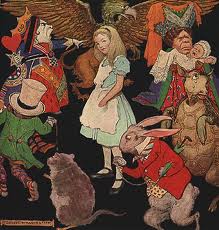
Alice in Wonderland is all about vasanas
As we lightworkers take on expanded responsibilities, nothing becomes more important than to have in our toolkit tools to manage the predictable outbreak of our ever-lurking core issues or vasanas.
I know each new situation that arises sees a fresh outbreak of mine. I’m comforted by what Sadhu Arunachala once said: “As one set of Vasanas is worn away, another takes its place.” (1) That implies that I’m not alone.
As my contribution to promoting discussion of the subject and to providing a toolbox for lightworkers needing to source their core issues, I’ve collected my favorite essays on the subject.
The new book is entitled Preparing For Ascension by Clearing Old Issues: How to Unconceal the Self R4 and can be downloaded at
https://goldenageofgaia.com/wp-content/uploads/2016/11/Vasanas-R4.pdf
It isn’t remotely like R3. It was put together from scratch and covers articles written from 2009 to 2016. OK, enough puffery.
Copy and distribute freely. I’ll post the “Introduction” from it, below.
Footnotes
(1) Sadhu Arunachala [A.W. Chadwick], A Sadhu’s Reminiscences of Ramana Maharshi. Tiruvannamalai: Sri Ramanasramam, 1961, 40.
Introduction
My interest in the subject of vasanas or core issues started with the study of Transactional Analysis back in the early 1970s: Games people played, scripts people lived, ego states, etc.
After I left graduate school in History, I felt an unquenchable thirst to study everything I could lay my hands on in Anthropology, Sociology, and Psychology – significant posturing and gesturing, spacing and positioning, dramaturgical analysis and motifemic analysis – everything I could soak up on patterns in human behavior.
And then I attended my first human-growth workshop.
That initial workshop led me to enroll in a three-month encounter group at Cold Mountain Institute and what was merely intellectual knowledge now became experiential knowledge and a little bit of realized knowledge as well – my first transformational experience occurred in an Enlightenment Intensive at CMI.
After that, the est Training introduced me to the study of what Werner Erhard called “records” – which were identical to what I was later to call “vasanas.” And more spiritual experiences followed.
Let me quote from a contemporary depiction of the est Training on what a record (or what I now call a vasana) is and how the mind acts:
“The mind is a linear arrangement of multisensory, total records of successive moments of now. Its purpose, its design function, is survival: the survival of the being and anything which it considers itself to be.
“When the being identifies itself with its mind, we call this state of affairs the ego and it means that the mind’s purpose becomes the survival of the mind itself.
“For the mind to survive, it tries to keep itself intact, it seeks agreement, and tries to avoid disagreement. It wants to dominate and to avoid domination, it wants to justify its points of view, conclusions, decisions, and avoid invalidation. It wants to be right. Running through it all, over it all, is the unending effort of the mind to prove itself right.” (1)
Perfect description. I don’t think I’ve heard the matter put better.
After the est Training, I went to India and est “records” now became Vedantic “vasanas.” Both words point to the same thing, which Linda Dillon calls “core issues,” perhaps the best term of all. Other terms are rackets, routines, numbers, competing agendas, plays, ploys, and so on.
Some are describing the elephant’s trunk, some its tail, some its leg, but all are pointing at the same animal.
Basically vasanas are the places where we’re stuck. They’re the memory of traumatic events as a result of which we reached a conclusion about life, made a decision, and constructed a conditioned pattern of response designed to save us from the same traumatic circumstances again.
Usually we refused, at the time of the original trauma, to experience the unpleasant, unwanted conditions that confronted us. We drew back. We resisted.
When we, in the present moment, re-experience those unwanted feelings through to completion, the vasana begins to unwind and eventually lifts.
Our vasanas, our conditioned responses, and the constructed self we fashion as a result of being inclined in these ways are the major obstacles to knowledge of ourselves.
Knowledge of ourselves is what embodied life is designed to produce. The purpose of life is for us to realize ourselves in a moment of enlightenment, at which time God meets God.
Once we experience our vasanas through to completion, let go of our conditioned responses, and demolish our constructed self, we stand revealed underneath all this overburden. The natural self is unconcealed.
That’s why completing, or “sourcing,” our vasanas is so important. Underneath them, we abide as our natural selves. And it’s that natural self that we’re tasked to uncover.
My work in this area has been dedicated to providing insight into how to extract ourselves from this primary existential trap that almost all of us find ourselves in, which Kathleen Mary Willis happily called “the binds that tie us.”
Thank you for taking an interest in the subject. And, if you go past that interest, use the upset clearing process as described here, and actually “source” your vasanas, I’ll be ecstatic.
It’s impossible to thank all the people who’ve assisted me, directly and indirectly, with this book. But I’d like to extend special thanks to Linda, Suzi, Karen, Sara, Kathleen, Paul, and Fran.
This book and others I’ve written are copyright-free. Please copy and distribute freely.
Footnotes
(1) Luke Rhineheart, The Book of est. New York: Holt, Rinehart & Winston, 1976, 174.

